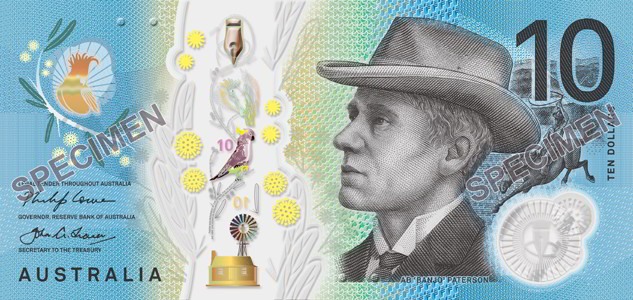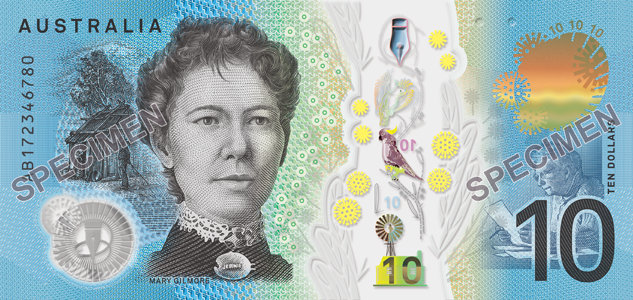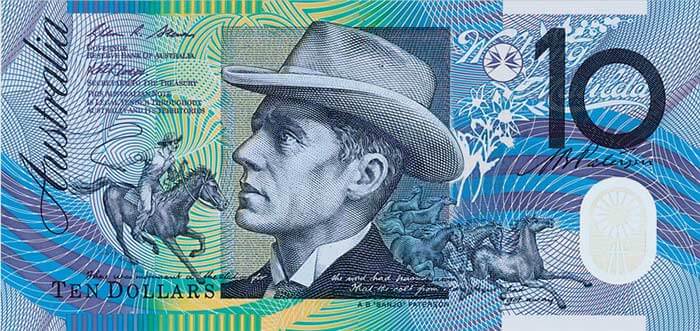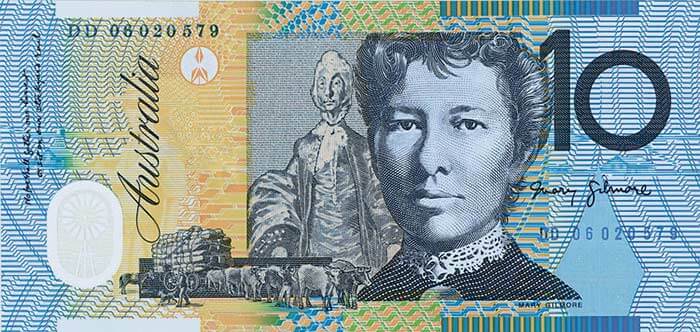$10 Banknote


What's on the new $10 banknote
The new $10 banknote has a range of innovative new security features designed to keep the banknote secure from counterfeiting. Each denomination in the new series of banknotes will feature a different species of Australian wattle and a native bird within a number of the security features. On the $10 banknote, these are the Bramble Wattle (Acacia victoriae) and the Sulphur-crested Cockatoo (Cacatua galerita).
The new $10 banknote retains the portraits of Dame Mary Gilmore and AB ‘Banjo’ Paterson, which are drawn from the same source photographs represented on the first polymer $10 banknote.
The banknote also depicts images from the era of Gilmore and Paterson's works. The homestead used in the design of the Reversing 10 is representative of the type of homestead referenced in Gilmore and Paterson's works. The hut on the Gilmore side of the banknote references life in the Australian bushland as described in her poetry. The image of the horseman on the other side of the banknote is the designer's interpretation of a horseman from the era of Paterson's writing.
Date of first issue
The new $10 banknote was released into general circulation on 20 September 2017.
Did you know?
The pseudonym under which Paterson wrote – ‘The Banjo’ – was the name of his favourite horse.
The wattle flowers on the new $10 banknote are paler than those on the new $5 banknote – just like the two wattles in real life.
The microprint features excerpts from Gilmore and Paterson's poems No Foe Shall Gather Our Harvest and The Man from Snowy River.


Who's who on the $10 banknote
Andrew Barton (Banjo) Paterson, a poet and ballad writer, was born in rural New South Wales. He began his career as a solicitor and achieved fame in his thirties after writing Waltzing Matilda and The Man from Snowy River, the themes of which are depicted in the designs of the banknote. In fact, his first book, The Man from Snowy River, sold out its first edition in a week and went through four editions in six months, making Paterson second only to Rudyard Kipling in popularity among living poets writing in English at that time.
Dame Mary Gilmore campaigned for a wide range of social and economic reforms, such as votes for women, old-age and invalid pensions, child endowment and improved treatment of returned servicemen, the poor and Aboriginals. Sensitive to the conventions of the day, she guarded her early teaching career by writing under pseudonyms. Gilmore also published numerous volumes of prose and poetry on a range of subjects, particularly outback and rural themes. An excerpt from her poem ‘No Foe Shall Gather Our Harvest’ appears on the far left-hand side of the banknote, and is based on a letter written by Dame Mary on 2 March 1942. Excerpts from the poem also feature in the microprint.
Date of first issue
The $10 polymer banknote was issued on 1 November 1993.
Did you know?
The $10 banknote is the first denomination in the polymer series to have something other than the value printed on it in microprint. The tiny, clearly defined print also shows the words to Banjo Paterson's The Man from Snowy River and Dame Mary Gilmore's ‘No Foe Shall Gather Our Harvest’.
The ‘Waltzing Matilda’ logo that appears on the $10 banknote was reproduced from the cover of the sheet music for the song, first published in 1903.

